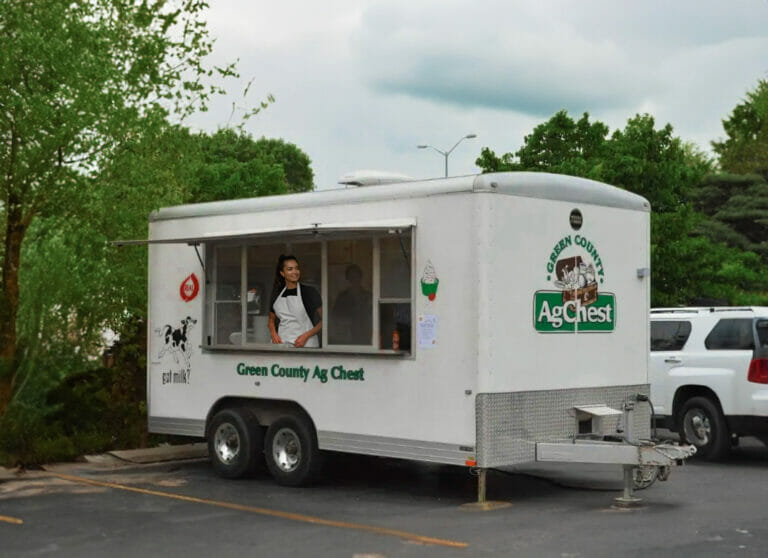Wisconsin Cheddar: It Doesn’t Get Any Better
Sharp Cheddar vs. Mild Cheddar vs. White Cheddar—whatever your type of Cheddar cheese—America’s favorite snack cheese was born in England…and perfected in Wisconsin.
America is a nation of immigrants—the great melting pot—and it stands to reason that our favorite cheese would come from somewhere else. No, our favorite is not the one that bears our name. “American cheese” (which can’t even legally be called cheese in America unless the word “cheese” is bracketed by “process” and “food”) is a meld of mystery ingredients that are a questionable reflection of the cheese it attempts to imitate: Cheddar.
No matter how you slice it, serving real Cheddar on your cheese tray or topping your favorite burgers is not only much tastier, it better reflects our country’s rich heritage…and it is truly America’s favorite.

What Is Cheddar Cheese?
Cheddar is a semi-hard natural cheese originating in the village of Cheddar, in the southwestern English county of Somerset. The caves of Cheddar Gorge provided the ideal conditions for aging the cheese to a satisfactory sharpness, and according to English tradition, only cheese made within 30 miles of nearby Wells Cathedral could be called Cheddar.
Today Cheddar is made in several countries, but most notably in the United States. Nearly all the cheese produced in America prior to 1850 was Cheddar, due to the British colonial influence. Cheddar production in Wisconsin began in the mid-1800s—around the same time as Swiss cheese production began—and by the 1880s, more Cheddar was made in Wisconsin than any other cheese variety. Today about a sixth of the U.S. Cheddar production—far more than that of any other state—comes from Wisconsin, which makes about as much Cheddar cheese as the entire United Kingdom. And it’s no cheap imitation of the “real” Cheddar, either; Wisconsin makes truly world-class Cheddars that have won Best of Class in world competitions…even beating the English favorites.

All Cheddar begins as milk, as does all cheese. When an enzyme complex known as rennet is added, the solid portion of the milk (curd) is separated from the liquid portion (whey). These fresh cheese curds are not only delicious as they are; they are the foundation for most of the world’s cheese. But what makes the cheese Cheddar is a process called—wait for it—cheddaring. In this process, the curd is heated, kneaded with salt, cut into cubes to drain the whey, and then stacked for aging. This is white Cheddar, and is the style favored in Vermont.
All in all, Cheddar is the most popular cheese in America except for mozzarella, and that’s only because of Americans’ insatiable appetite for pizza. Come to think of it, a little Cheddar mixed in with that shredded mozzarella is many a pizzeria’s secret for adding a burst of color and a deeper, richer flavor to the top of a pie.

Types of Cheddar
There are several types of Cheddar cheese made in America: mild, medium, sharp, and extra-sharp (depending on age), white Cheddar, and the regional styles made in New York and Vermont.
- Mild Cheddar: Mild Cheddar is the youngest and mildest version of Cheddar cheese. It has a smooth, creamy texture and a subtle, buttery flavor. It undergoes a shorter aging process, typically around 2 to 3 months.
- Medium Cheddar: Medium Cheddar is aged slightly longer than mild Cheddar, usually between 3 to 6 months. It has a firmer texture and a slightly stronger flavor profile. Medium Cheddar strikes a balance between the mild and sharper varieties.
- Sharp Cheddar: Sharp Cheddar is aged for a longer duration, typically between 6 to 12 months. This aging process intensifies its flavor, resulting in a tangy, robust taste. It has a crumbly texture and is commonly used in cooking or enjoyed on its own.
- Extra-Sharp Cheddar: Extra-Sharp Cheddar, often what people think of as “Wisconsin Cheddar,” undergoes an extended aging process of over 12-15 months, sometimes up to several years. This extended aging imparts a deep, complex flavor profile with a sharp and pronounced tang. Extra-Sharp Cheddar has a drier texture and is often used as a flavor enhancer in dishes.
- White Cheddar: While Cheddar cheese is traditionally orange due to the addition of annatto, white Cheddar refers to a version made without any artificial coloring. It can be mild, medium, sharp, or extra-sharp in flavor, depending on its aging. White Cheddar has a pale creamy color and a rich, slightly nutty taste.
- New York Cheddar: New York Cheddar is a regional style of Cheddar cheese produced in the state of New York. It is typically aged longer than the standard Cheddar, resulting in a sharp and tangy flavor. New York Cheddar often has a crumbly texture and is well-known for its robust taste.
- Vermont Cheddar: Vermont Cheddar is another regional style of Cheddar cheese, made primarily in the state of Vermont. It is often aged for an extended period, similar to New York Cheddar. Vermont Cheddar has a full-bodied flavor, combining both sharp and nutty characteristics. It is known for its rich, creamy texture and complex taste.
These variations in Cheddar cheese allow for a wide range of flavors and textures, catering to different preferences and culinary applications.

Classic Cheddar Cheese
Firm and smooth with a mellow flavor, this medium cheddar is sealed in red wax to lock in all its full-bodied taste and texture.
$22.99
Why is Cheddar Cheese orange?
The Cheddar most Americans know and love is actually colored prior to cheddaring with annatto, an odorless vegetable dye from the seeds of the annatto plant. Also known as achiote seeds, they lend a very subtle nutty flavor and intense reddish/orange color to foods in Mexico, Latin America, and the Caribbean. While some claim annatto adds a nuttier character to Cheddar cheese, it’s not really used in enough concentration to add much flavor, if any. The real flavor difference in Cheddar comes from aging.
As Cheddar ages—whether in the caves of Cheddar Gorge or humidity-and-temperature-controlled creamery rooms in Wisconsin—its rich, mellow flavor becomes increasingly sharp and complex. Its firm, smooth texture also changes, too, becoming more granular and crumbly…and as the flavor sharpens with age, so does the price.
Sharp Cheddar has generally been aged for six to nine months, but “sharp” is a relative term and there are no regulations governing the term. Extra-sharp or “vintage” Cheddar is typically aged at least 15 months…but two-year and four-year Cheddars are common in Wisconsin, and the true Cheddar fanatic can find treasures like eight-year, ten-year…even 14-year Cheddar. At this age, the cheese can no longer be sliced neatly; it flakes off into irregular shards with an intensely piquant taste accented with little crystals of naturally occurring calcium lactate that add a delicately salty crunch. This is not the type of Cheddar one layers thickly on a grilled cheese sandwich or stirs into a mac and cheese casserole; it is savored slowly with a glass of fine wine or a craft beer, and treated with the respect that goes along with its substantial price. But the good news is that a perfectly sharp and delectable Cheddar with similar—if not as intense—qualities can be found at non-collector prices to be enjoyed by cheese lovers of fine taste and average means. And you won’t feel guilty about using it in your macaroni or grilled cheese.

Best Uses for Cheddar Cheese
As mentioned earlier, a little bit of Cheddar adds character to the shredded mozzarella atop a pizza…but there’s so much more you can do with it. Add Cheddar—especially the aged stuff—to enhance cream-based soups or sauces for steamed vegetables and baked dishes. Cheddar-broccoli soup is a favorite, and it’s pretty hard to imagine a better choice than Cheddar for a traditional grilled cheese sandwich, shredded on a baked potato or melted over a burger. And what better way to use America’s favorite snack cheese than to pair it with another American classic: apple pie! This may sound funny to some, but Cheddar and apples go together beautifully. Just serve a thick slice of sharp Cheddar (or mild, if you prefer) with a nice warm slice of apple pie, or really get creative and add shredded Cheddar to the crust. But the best use of Cheddar, to a true fan, is to just serve it au naturel with the right wine or beer.

Sharp Cheddar Cheese
Our cheddar cheese is made for those who appreciate the character and flavor that can only come from careful aging and curing…an art for which Wisconsin is famous.
$22.99 – $42.99
Food and Wine Pairings with Cheddar
Wine: Cheddar is better with a fruit-forward red wine like zinfandel, syrah or merlot, or a crisp white like pinot grigio/pinot gris, sauvignon blanc or riesling.
Beer: The rich, creamy flavor of Cheddar stands up well against a dark, toasty porter or stout, or a hoppy pale ale. Or continue the apple pie theme and serve it with a cider or fruit beer.
Spirits: Serve Cheddar as a cheese course (after the main course, before or in place of dessert) with a brandy or Madeira.
Foods: Apples, of course…plus pears, onions, tomatoes, dried fruits, nuts, and a wide variety of sausages and crackers.






Comments (10)
lee diciglio
my sister loves all kinds of cheese, especially on her pasta and in her scrambled eggs. She is particularly found of aged Swiss cheese with salami and turkey sandwiches. I am found of Italian cheeses for pizza and pasta. I grate my own cheese and store it in a container when needed.
Best Regards,
Lee Diciglio
Dennis Worley
I love Cheese now it’s just my Favorite Snack and with a block of Cheese and A cold Beer you just can’t go wrong. I Must try that onion cheese.
Latrice K
Wow!!! Cheese, cheese, cheese!!! I love any kinds of cheese ever since I was a child. And cheddar is one of my favorite. Wine and cheese, are really good partners!
David prepster
Having grown up in Wisconsin,shebougan county,left for navy,have eaten cheeses in France an Germany,,yours is still the best in the WORLD, now being married 50 years,live in Indiana,an order your cheeses an fruit cakes,shipped to me,,my life in comming golden years enjoying,your cheese an other products,still makes me feel st home from Wisconsin ,,,⚓️🇺🇸👴🏻
Red Onion Cheddar Cheese Review - Cheese a Week #3
[…] cheese was originally made in England, and was therefore the first type of cheese that was produced in America way back in the early […]
G & M Strack
I’m an ex-Wisconsin resident. Lived in Brookfield. Retired to Colorado many years ago. Always enjoyed Wisconsin Cheese and Sausage. I know all of Wisconsin well, having worked and traveled all over the state. I usually found time to visit all the cheese sources. My wife and I miss them. Let;s see if we can get some of our favorite items back again.
severson
We’re more than happy to help you receonnect with your Wisconsin favorites – that’s what we’re here for! Browse around https://www.wisconsincheeseman.com and find great cheeses, sausages and more for yourselves and to give as gifts. Thanks for writing!
Ahmed Muneer Akeel
Gentlemen
I’m interested in your cheddar cheese in blocks.
Please quote your best price CIFC5% Lybian port for 1x20ft fcl or multiples.
Thank you for your urgent reply.
Regards
Muneet
severson
Sorry; we’re a retailer. We don’t sell wholesale or internationally.
Dennis Worley
That’s some Good Cheese Folks I Just recived 3 lbs of Sharp and Let Me say OMG that’s some good Stuff. If i was outside i would be Fighting some rats off i will tell you That.